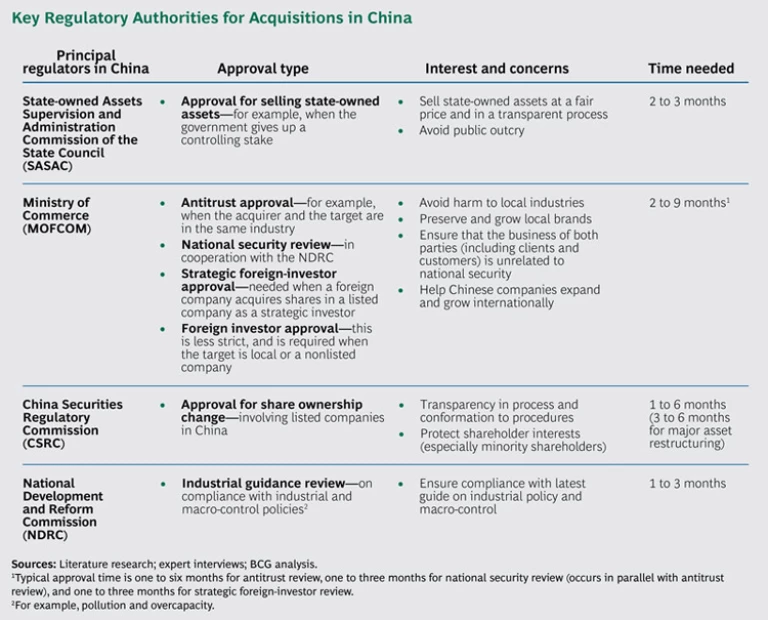Many multinational companies have used M&A to establish a presence or expand operations in the world’s second-largest economy. But many more have not, especially in recent years. According to Thomson Reuters, inbound transactions represented only about $75 billion of the $287 billion in total M&A volume in China in the first three-quarters of 2014 (although it should be noted that $75 billion is double the levels seen in the previous ten years). And fewer than 50 out of some 2,500 deals since 2009 have been acquisitions by multinational corporations valued at more than $100 million in which the buyer has taken ownership of 30 percent or more of the target (not including pure financial investments such as private-equity acquisitions or asset restructurings).
Prospective multinational acquirers are frequently deterred by the misperception that value-generating acquisitions are nearly impossible in China. They believe they cannot attain majority control; while this is true in a few industries, it is more the exception than the rule. They see the regulatory process as opaque and painstaking to navigate without deep existing personal connections. They believe that asking prices are too high and can be justified only by realizing a degree of synergies, particularly revenue synergies, that is somewhere between difficult and impossible to achieve. They doubt their ability to bridge differences in culture and management systems and effectively integrate a Chinese operation with their own.
Our experience with numerous multinational acquirers of Chinese companies has demonstrated that these hurdles can be overcome. Successful M&A in China is by no means easy: every step of the process, beginning with due diligence, presents a unique set of challenges. Two critical steps are particularly daunting: regulatory approval and postmerger integration. Both are difficult but need not be seen as impenetrable black boxes. Regulatory approval can be approached in a systematic manner, and cultural differences can be decoded to create a customized integration process.
This report presents a game plan for dealing with each of these challenges in China’s unique M&A environment.
The Regulatory Dragon Can Have Many Heads
Securing regulatory approval in China is complex but can be effectively managed in most cases. For foreign buyers that are used to dealing with one or two regulatory bodies in developed markets, the first surprise is the number of regulatory stakeholders in the Chinese process. Depending on the business of the acquirer and the target, the industry, the size of the deal, and other factors, approval can be required from as many as half a dozen different bodies, and each one can have several levels—national, provincial, and local—as well as multiple departments. (See the exhibit below.) Provincial and city governments, as well as party officials, can also become involved. Each authority will have its own list of concerns. Gaining regulatory approval requires both managing the process strategically and organizing and deploying allies that can help.
Managing the Process
The industry and markets involved, the location of the target company, and whether the target is a state-owned enterprise all affect the nature and complexity of the review. At the center of the process is the Ministry of Commerce (MOFCOM), whose purview officially includes antitrust, foreign investor approval, and national security—the latter in cooperation with the National Development and Reform Commission (NDRC). The China Securities Regulatory Commission (CSRC) is involved if the target is a listed company, and acquisitions of state-owned companies are reviewed by the State-owned Assets Supervision and Administration Commission of the State Council (SASAC).
MOFCOM’s approval process is probably the most complex, because the antitrust review can consider a wide variety of factors, including quite often the views of the public (frequently as expressed through the media as well as online), competitors, and industry groups. If a deal is particularly large or involves a well-known brand or an already concentrated sector, MOFCOM may seek input from industry participants and associations, and track consumer concern through the media and online. Strong opposition from industry players can be sufficient to kill a deal. One private-equity buyer learned this lesson the hard way when its proposed acquisition of a Chinese equipment company ran into strong objections from the company’s main competitor, which was able to convince MOFCOM that the deal was detrimental to the industry. In another instance, the combination of complaints of overconcentration from competitors and consumer outcry in the media was sufficient for MOFCOM to deny approval.
Each regulatory body will expect the acquiring company to have anticipated—and be ready to address—its particular concerns. Westerners too often misinterpret the impact of the Chinese cultural phenomenon of guanxi, which they misconstrue as a murky system of “connections” or “relationships,” on the regulatory approval process. Guanxi is actually rooted in empathy—the concern for someone else’s interests when taking an action of one’s own. Thus, each regulatory body will be looking for signs that an acquiring company understands, and has a plan for addressing, the social as well as economic considerations that fall within the parameters of the regulator’s authority. Each will expect the company to demonstrate this understanding through its outreach efforts and to engage in a back-and-forth discussion about these and other considerations throughout the approval process.
Smart companies will prepare for this process thoroughly—mapping out the various stakeholders’ interests and concerns, and planning a comprehensive program of outreach and communications. They will then manage the process aggressively. The concerns and interests of the various government and regulatory players are rarely mysterious. Local governments care about investment, the tax base, any potential impact on the local economy and local industries, and, of course, employment. Many of the central government’s priorities were made clear in the decrees on market and financial reform following the Third Plenum in November 2013.
In designing their outreach program, acquiring companies should prioritize the authorities they need to communicate with, often starting at the local level. If local authorities are convinced early on of the value of a deal to their jurisdiction and economy, they can be effective allies in the approval process, as we explain below. Acquirer and target also need to speak from the same script about both the business logic of the deal and its social impacts. Both need to engage in an iterative, informal communication process that is as much about listening and adjusting key messages, on the basis of the reactions to them, as it is about “selling” the deal’s rationale and benefits.
For example, within ten days of signing an agreement for the acquisition of a majority of its shares by Nestlé, the president of the Chinese food company Yinlu prepared a report on the transaction for the local government, explaining the deal and seeking to ease any concerns over the potential disappearance of Chinese national brands. He emphasized that the two companies planned to keep Yinlu’s headquarters intact, expand the local plant, and put Nestlé’s instant-coffee products under Yinlu management in China. The report included estimates of future revenue and the combined company’s contribution to the national and local economy, including the taxes to be paid in Xiamen, where Yinlu is based. The companies also made clear that Yinlu would keep its brand separate from Nestlé and that Yinlu’s senior management team would run the combined company. Yinlu’s efforts, along with Nestlé’s, to address concerns and convey benefits up front won the companies a valuable ally in the approval process.
Acquiring companies need to be up to date on approval processes so that they can address the steps that are actually critical, which can be more detailed than those laid out in official documents. These processes are sometimes complex, but this situation is changing and for the better: the government is determined to make approvals more transparent and efficient.
Knowledge of the process and connections at multiple levels of both government and party are still important. Most international acquirers will want an experienced Chinese guide—or team of advisors, since not all advisors can help equally well in each step of the process. Companies should choose their team members carefully. Legal and financial advisors can vary substantially in their willingness to go beyond general opinions based on past experience and commit to specific recommendations and timelines for the deal under consideration. Strategic advisors can help with industry specifics, the assessment of deal synergies, the phasing of the deal process, and postdeal execution. Perhaps most important, though: no acquiring company should think it can fully delegate management of the approval process to a third party. The authorities will want to see that the company is actively involved in directing the process itself.
Organizing and Deploying Allies
Consensus building is critical in China. An acquiring company’s most important ally is often the stakeholder with the most to gain from the deal’s success. Many foreign acquirers have had success reaching out to local regulatory authorities first, seeking to underscore the benefits of the transaction for the local economy (expansion plans, for example) and to mollify local concerns. As the example of Nestlé and Yinlu illustrates, recruiting a local champion who is “inside the process” can help enormously as companies move up the approval ladder—as can having someone other than the acquirer itself in a position to explain the deal to various stakeholders.
Whirlpool’s acquisition of Chinese manufacturer Hefei Sanyo in 2014 offers another model for success. The deal was complex, even by Chinese standards, given that the target was a listed company and three times bigger than Whirlpool’s Chinese operations. Whirlpool also owned a joint-venture production facility with another competitor. The Hefei government was a 35 percent shareholder of Hefei Sanyo, and the second-largest shareholder—another multinational with a 29 percent position—wanted to divest. Whirlpool developed a package of incentives designed to appeal to the local authorities. The incentives included an aggressive growth strategy for the Chinese company, relocating Whirlpool’s China headquarters and R&D to Hefei, and expanding local operations. Whirlpool also emphasized its intent to use Hefei Sanyo’s strong platform and operations as the basis for future growth of its China business, including manufacturing finished products and some critical components. Whirlpool succeeded in enlisting the Hefei government as an ally, and senior government officials played instrumental roles in helping to address the concerns of MOFCOM and CSRC and in accelerating the approval process. Whirlpool also succeeded in acquiring majority ownership of a listed Chinese company in one step.
Industry associations are influential in China and another important target for timely outreach. They can play persuasive roles (and acquirers can prevent them from being co-opted by competitors to oppose a transaction) if they are brought onboard early. They can be especially influential in the MOFCOM antitrust approval process since MOFCOM usually solicits their opinions early on. The target company itself can also have valuable connections that help move the process forward.
The media are another potentially instrumental factor. It’s important to manage public, as well as private, communications aggressively. This includes closely monitoring consumer sentiments on online bulletin boards and in chat rooms. Local public-relations advisors who can help both anticipate and manage media and public reaction can be an important addition to the team. They can have contingency plans ready to go should negative reactions surface, for example.
Managing public opinion is especially important if the target is in a high-profile business or has one or more well-known Chinese brands. The government maintains lists of “famous brands” and “time-honored brands.” If a target company has brands on either list, MOFCOM is likely to impose stricter approval requirements and solicit input from other agencies such as the NDRC. In addition, MOFCOM and the NDRC have published a “foreign investment guide” in which they divide all industries into three categories (those in which foreign investment is encouraged, restricted, or prohibited). For acquisitions in industries on the foreign-buyer “restricted” list, stricter requirements also apply. For example, deals valued at more than $50 million are subject to central MOFCOM approval, while in “encouraged” industries, only transactions worth more than $300 million require central MOFCOM review. Following the Fourth Plenary Session of the 18th Communist Party of China Central Committee in 2014, China has been looking to streamline investment approvals and delegate more reviews to the local level. A draft update of the foreign-investment guide released by the NDRC in November 2014 would reduce the number of sectors that limit foreign investment from 79 to 35.
Some industries do have limitations on the percentage of ownership that foreign companies are permitted to acquire. Foreign ownership is limited to 49 percent in telecom infrastructure, for example, and 50 percent in telecom value-added services. A few special industries (mainly financial services and economic “backbone” industries such as banking) can have stricter restrictions. Foreign ownership of commercial banks is held to 25 percent; in life insurance, the limit is 50 percent. For “industries where foreign investment is encouraged” by MOFCOM, such as infant food, biopharma, and software development, there is no ownership limitation. The draft update of the foreign-investment guide lists some 350 sectors that encourage foreign investment.
Realizing Value Through Postmerger Integration
Valuations in China are high, and in many cases they can be justified only if the buyer achieves significant synergies. China is a growth market, so these synergies often entail increasing revenues rather than cutting costs. Many multinationals are more experienced at cutting costs—and are therefore more confident about their ability to do so, since cost savings are typically based on concrete onetime actions such as head count reductions or procurement savings. Revenue synergies can be more uncertain and cannot be achieved by simply allowing the acquired company to run as a stand-alone entity. These synergies put a premium on effective PMI. Indeed, many foreign acquisitions in China fail to realize their potential—and plenty just flat out fail—because of unsuccessful PMI, which can result not only in lost synergies but also in damaging misunderstandings between the acquiring company and the target.
In our experience, there are four primary causes of unsuccessful PMIs between multinational buyers and Chinese companies:
- Failure to bridge divides rooted in culture, business thinking, and management approach, as well as failure to build trust early on between the acquiring company and the target.
- PMI planning that does not start until the acquisition is near completion.
- Misunderstandings over majority ownership and “control” in China.
- Failure to customize the PMI process for the Chinese market.
Failure to Bridge Divides
Multinational and Chinese companies almost always have very different cultures, philosophies, management practices, and ways of doing business. Failure to address these differences early on leads to lost opportunities, misunderstandings, and, too often, loss of trust.
One area of potential misunderstanding, for example—on which many mergers founder—is personalities versus process. Chinese companies are often driven by strong personalities rather than management processes. In fact, Western processes can initially appear unnecessary or impractical to Chinese managers, who rarely have experience being embedded in multinational matrix organizations. When new owners unilaterally impose new processes from above, confusion and mistrust frequently result. Too often, both sides underestimate the extent of the differences until they start working closely together—but by then deep chasms have formed.
There are other differences as well. Chinese companies often emphasize top-line growth, especially in fast-growing sectors, while multinationals are equally focused on the bottom line. Chinese companies tend to have more hierarchy in their management structures; Western companies are flatter at the top. Deference to the leader is a principal dynamic in Chinese management: budgets and targets are decided unilaterally, in a top-down fashion, with instructions issued from above. Chinese companies also tend to follow a more adaptive management philosophy: they like to experiment, observe, and adapt, making quick decisions on the basis of current market conditions. This approach, which eschews long-term planning, often frustrates Western owners.
Decoding these differences takes a systematic effort, and the burden falls more heavily on the acquirer to invest the necessary time to gain a working-level understanding of how the acquired company functions on a day-to-day basis. A good first step is mapping out the target company’s management system and processes: how it sets goals, tracks and evaluates its business performance, and corrects actions. What are the company’s key performance indicators and how does it translate them into compensation? The acquirer’s management can gain this understanding through interviews with the target’s management and by sitting in on critical meetings. It can also use a thorough commercial due-diligence process, sometimes involving third-party agencies and dedicated resources, to understand the target’s commercial approach, especially its go-to-market system. There are often intricate connections among the sales team, distributors, and retailers that are not immediately apparent to foreign eyes.
The acquiring company’s management will also want to sit down as soon as possible with the target company’s CEO to engage in an assessment of senior executives. Having the acquired company’s people join the integration team permits a firsthand look at the target’s talent and helps facilitate a shared understanding of the vision, goals, strategies—and processes—of the combined operation.
Multinational acquirers can best build trust with their new partners by helping the acquired company’s management understand the acquirer’s culture and priorities. They should look for early opportunities to show how they can add value to the local business—for example, by bringing capabilities and know-how that are needed by Chinese companies. They should also take pains to exhibit a long-term commitment to growth in the Chinese market and focus attention from the earliest stages on whether their and the target’s management share the same high-level vision for the combined company.
Too often, foreign acquirers fail to recognize that the processes they consider basic are anything but basic to Chinese companies. Well-meaning attempts to impose process-driven management techniques on a newly acquired business end up undermining the entrepreneurialism and nimbleness that are often behind a Chinese company’s success. Smart acquirers will determine which of the target company’s processes can be changed and which should not be touched. They will develop a detailed integration plan for the first year that clearly communicates the future direction internally and to business partners. They will understand that integration can take longer in China: the typical integration period is three years.
Late Postmerger Planning
The second major mistake that many multinationals make is leaving critical decisions until late in the acquisition process. By this time, the acquiring company has already missed important opportunities to work with the target to build consensus on such questions as company vision, achieving synergies, and the approach to merging operations.
Failure to reach consensus on the vision for the combined company early on, including a high-level growth plan, almost inevitably results in wasted time down the road—if not more serious rifts—as the two managements try to work out misunderstandings from positions of confusion and mistrust. This can often complicate the already tricky task of extracting the value of the transaction through realizing synergies. Synergy is a new concept to many Chinese executives; they are used to looking at the overall top and bottom lines.
Effective acquirers both compel agreement on vision and budget time to reach concurrence on the synergies the combined operations can achieve. Some acquirers focus on specific actions necessary to realize the synergies, starting with easy-to-implement steps, before tackling more complex issues; this is often the best way to engage Chinese partners in the process. Others design a case-specific approach that helps demonstrate synergies to their local partners, translating them into operational metrics that managers can understand and act on.
A third issue best tackled early (and decisively) is whether to integrate the acquired company with the acquirer’s own Chinese operations or leave it as a stand-alone business. In our experience, it generally makes sense to integrate when either party has a strong platform for growth and capabilities that can immediately add value for the other, or when there is a strong leadership team on one side that can push the integration forward and manage the combined business.
For example, Groupe SEB vastly expanded its small base of business in China with the acquisition of 53 percent of Supor, the country’s third-largest small-appliance manufacturer. SEB kept Supor’s management team largely unchanged and exploited Supor’s distribution network by using it as the primary sales channel for SEB’s own branded products. SEB also folded its local sales force into Supor’s. As a result, sales almost doubled to reach RMB 4.1 billion in three years, the company increased its market share by two points, and its net profit margin rose from 5 percent to 7.5 percent before the deal took place.
Some multinationals believe it is better to leave the newly acquired company as a stand-alone operation if the business is on a good growth trajectory with a strong and stable senior management team and the two companies share the same vision for the future. L’Oréal, which already had 3,500 employees in China in 2013 when it acquired Magic Holdings International, determined it could best build on Magic’s strong position in the fast-growing facial-mask category by relying on Magic’s existing management and adding L’Oréal’s own expertise to the mix, particularly in R&D. Nestlé is another company that did not intervene extensively in most of its early acquisitions’ operations.
For most acquirers, however, it’s hard to realize synergies without integrating operations. And without integrating, it’s hard to justify the premium valuation paid. Resolving this decision early removes uncertainty for the management and employees of the acquired company (as well as, in many cases, the management and staff of the acquirer’s own operations). The earlier there is clear understanding on how the integration will proceed, including critical staffing issues, the smoother the PMI is likely to be. Removing these uncertainties can also clarify other PMI decisions.
Misunderstandings over Control
A common misconception among multinational buyers is that majority-share ownership confers control. This is not always the case in China. A majority share may win more board seats, but in reality the board may exert very little influence over the company’s operations. The managing director and the general manager often have the authority to dictate operations, and they can act—and usually do—with little or no supervision from the board.
If a multinational owner intends to exercise control, it needs to make the intended governance structure explicit up front, defining the board’s and the management team’s composition and securing the right to appoint board members and the acquired company’s managing director and general manager. Some acquirers, including those that have made a number of successful acquisitions in China, use a well-defined and experience-tested approach. They have clear criteria for gaining management control of acquired companies and make those criteria clear during negotiations. They are willing to walk away from a deal if the target’s management will not come to terms. Some multinationals with multiple acquisitions have dedicated, experienced local integration teams to take over and run the target’s business after integration. These acquirers make a practice of articulating a clear value proposition, and they build a track record of helping acquired companies grow.
Other companies choose to gain control over time by demonstrating their ability to add value and by building trust. Both approaches require addressing the issue of control up front.
Failure to Customize the PMI Process for Local Realities
Following a standard PMI process is often a road to ruin in China—although that doesn’t stop many foreign companies from trying. Experienced acquirers have learned that adapting the standard PMI approach to Chinese realities is essential to achieving any level of successful integration. Program management requires disciplines and metrics, but there is a risk of overwhelming the target company with too many meetings and interactions.
For example, it’s often unnecessary to hold frequent formal PMI meetings, especially large group sessions, which can actually be counterproductive in China because managers will be reluctant to discuss and resolve problems on the spot. It’s more effective to break down the issues and engage smaller groups when necessary to address emerging ones. Similarly, using a simple template for the integration plan and for tracking and reporting, and, wherever possible, minimizing people’s time on paperwork, are likely to further PMI goals. This doesn’t mean throwing out the PMI playbook and improvising. Some standard PMI rules and procedures should always be followed:
- Defining Priorities and Critical Deliverables. Acquirers need to recognize that this can be a moving target, so they should continually update priorities for the team. Setting out clear goals and expectations can help local management focus on the most important tasks. Assuming responsibility for newly imposed PMI tasks as well as daily management duties can be overwhelming for many people, and they can lose focus.
- Establishing Clear Ownership for Management Tasks. It’s essential to assign individual responsibilities early and to give visibility and responsibility to local senior managers. Many issues can be interdependent, so leaders need to be assigned and held accountable.
- Monitoring Critical Decisions and Activities. Acquirers need to make sure that local decisions are made and implemented and that the issues that inevitably emerge are resolved quickly.
- Establishing a Dedicated PMI Team. A part-time effort on the part of a few executives will not work. Sufficient resources need to be dedicated to overseeing the above steps.
Dealing with such factors as differences in culture and management approach can be structured in a systematic manner, and a customized integration plan can be developed. In general, multinational buyers should apply PMI principles with care and remember that a light and flexible program-management approach is usually most effective. The focus should be on value creation instead of process management.
Planning Avoids Pitfalls
Multinational companies should not be put off by the complexities of M&A in China. For many, M&A can be an effective and quick way to enter the market or expand. And even in a fast-growing market such as China, organic growth often has its own challenges, such as customizing products to local needs or building distribution networks. M&A involves minefields and pitfalls, to be sure, and the challenges companies face are not necessarily proportional to the size of the transaction. Indeed, a company may well need to devote more resources and attention to a small deal in China than to a larger transaction in another market. However, the two big hurdles—capturing synergies to justify high valuations and clearing the regulatory approval process—can both be successfully managed. Companies should start by asking themselves some basic questions at the beginning of the process.
With respect to regulatory approval:
- Do we know the central and local governments’ attitudes to foreign investment in our industry? Are we familiar with the target’s role in, and importance to, the local community and economy, and its industry?
- Do we have capable external advisors who can help guide us through the regulatory approval process?
- Have we identified the allies that can help us succeed?
- Do we know the specific concerns of the regulatory agencies from which our deal needs approval? Can we foresee the barriers we have to overcome? Are we focusing our resources on the most critical approval steps?
With respect to PMI:
- Do the two companies share a single vision for the future of the combined company?
- What is our expectation for future board and management control? Does our Chinese counterpart have a different expectation?
- Do we know how the target company is run and how it makes important strategic and operational decisions?
- Do we have a clear endgame for the integration of the acquired company?
- Do we have a plan for which processes we will—and will not—impose on the Chinese company?
- Will the integration plan affect the underlying drivers of the company’s success? If so, do we have a plan to mitigate the risks of imposing change, and have we looked closely at whether the changes are really necessary?
- Do we have a PMI approach that is customized for China, including a systematic approach to understanding the target’s management system and culture?
Smart buyers will approach China with eyes wide open and develop plans to address these issues as soon as it appears that negotiations may lead to a deal. When the team working on the transaction gets close to finalizing the deal, other teams should start working out plans for gaining the requisite approvals and moving forward with PMI. On the day the deal is signed, both companies can hit the ground running, ready to take on the challenges ahead.










